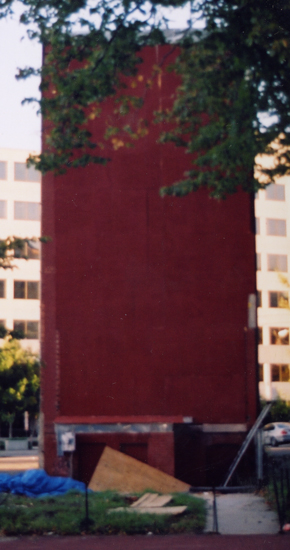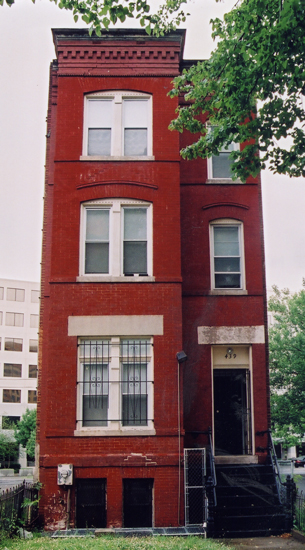Ideas on the DC Historic Preservation Agenda
Of course, since there is this upcoming meeting, there has been some discussion about some of the issues. The agenda for the meeting seems pretty packed. I hope we can get to some of the meaty issues. Here's an email that I sent around on some, but only some, of my thoughts on this.
1. Everyone should read Donovan Rypkema's paper on historic preservation and DC, which was commissioned as a thought paper to help guide the Comprehensive Plan revision process: "Planning for the Future, Using the Past: The Role of Historic Preservation in Building Tomorrow’s Washington, DC."
2. I too think that Alley Dwelling issues need to be reconsidered. Encouraging this will add a diversity of housing types, and provide more "eyes on the street" in the interior of squares, which will add safety.
An urban design studio class taught last fall by Terry Williams at Catholic looked at H Street, and among their work was a focus on alley dwelling "accessory units." I think they came up with some good ideas that need to be communicated more widely within the broader community. Currently, lot coverage regulations in the Zoning Code make bringing back alley dwellings very difficult.
3. As many people know, I am particularly concerned about the demolition of properties eligible but not listed on the DC Inventory-National Register. Current DC law affords protections only for listed properties/contributing structures in an historic district, and no protections whatsoever for anything else (other than filing a nomination, which can stop the process for awhile).
The Comprehensive Plan says that housing is a good thing and that historic preservation is a good thing. So the other laws should use those as principles in guiding them.
The City of San Francisco has a good policy for addressing this issue, which is online here. It focuses strictly on residential demolition. (This is an issue with the Board of Condemnation of Insanitary Buildings as well, but that is at least being addressed currently, although we are still losing buildings in the interim.)
I think it's important to look at both, residential and commercial properties, and to consider
4. Creating a fund for moving buildings. I know that strict historicists don't like the idea of moving buildings, but if you take the position that losing buildings is a bad thing but that it is difficult to upright the maw and inexorable nature of development, then we need a backstop position in order to be able to satisfy multiple constituencies.
 The developer, Trammell Crow?, ripped off the facade of the building at 439 Massachusetts Avenue NW. The permit for this rape of a facade called it an "alteration." Photo by Peter Sefton.
The developer, Trammell Crow?, ripped off the facade of the building at 439 Massachusetts Avenue NW. The permit for this rape of a facade called it an "alteration." Photo by Peter Sefton.See this page on Victorian Secrets for a couple more photos of the buildings on the 400 block of Mass. Ave. NW where the developer ripped off the face of the buildings, likely to prevent a nomination from being filed. (Since the assembler is Trammell Crow, developers of the property that includes Hochenmeyer Hall, for which a landmark nomination was filed, it's pretty likely that is why this was done.) Rather than have this happen again and again, let's set up a way to move buildings.
 439 Massachusetts Avenue NW in happier times. Photo by Peter Sefton.
439 Massachusetts Avenue NW in happier times. Photo by Peter Sefton.5. HPO is very big on the idea of conservation districts, to provide protections for eligible properties. I still haven't made up my mind. In any case, the Business revitalization district zoning overlay in Cleveland affords a model that could be enacted without the possible negatives that often accompany attempts at creating historic districts and the like.
I have appended some testimony about that below. BRD zoning could provide both for design review and demolition protections. Both are necessary. Demolition protection without design review only gets us half way.
From testimony, reprinted from this blog entry:
The City of Cleveland has created a zoning overlay called a "Business Revitalization District" to "...ensure appropriate design of buildings, signage, and property in business areas targeted for concentrated improvements. More specifically, it is the purpose of this [zoning] chapter to achieve among others, the following objectives:
a) To preserve jobs, tax revenues and local services through the upgrading of business districts;
b) To safeguard the public investment in revitalization through prevention of inappropriate signage and property design in business areas targeted for concentrated public improvements and rehabilitation financing: and
c) To protect residential and commercial property values, particularly for businesses and residents committing private funds to rehabilitation in designated revitalization areas (Ord. No. 1664-88. Passed 10-3-88, eff. 10-6-8)."
This reasoning seems indisputable. Scarce economic resources, and in places where investment can be risky, requires that we ensure that property design, construction, and signage is created that meets the highest standards of quality urban design. (In any case, it is the opinion of this writer that all projects in the city, regardless of location, should attempt to achieve the best urban design standards and expectations, following the intentions of both the original L’Enfant Plan for the City of Washington, and its "successor," the McMillan Commission in 1901.)
High standards can best be attained through the application of design guidelines and careful project review. In fact, projects funded by various agencies of the DC Government, and in particular the DC Department of Housing and Community Development ,should set the standard for "appropriate design of buildings, signage, and property in business areas targeted for concentrated improvements." These projects have significant impact in neighborhoods throughout the city, and it is imperative to ensure that they are uniformly excellent!
Creating a Business Revitalization District Overlay providing for design review and protections against untoward demolition is a necessary tool for ensuring attention to placemaking and quality in urban revitalization.



0 Comments:
Post a Comment
<< Home